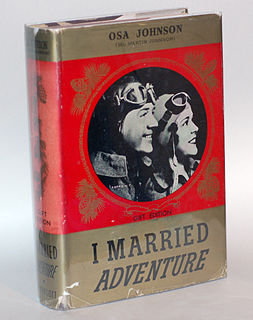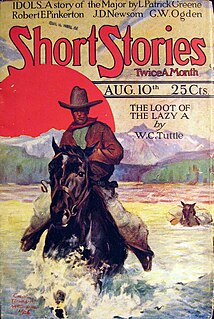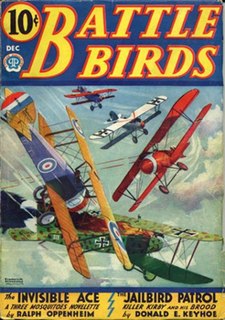Pulp magazines were inexpensive fiction magazines that were published from 1896 to the late 1950s. The term "pulp" derives from the cheap wood pulp paper on which the magazines were printed. In contrast, magazines printed on higher-quality paper were called "glossies" or "slicks". The typical pulp magazine had 128 pages; it was 7 inches (18 cm) wide by 10 inches (25 cm) high, and 0.5 inches (1.3 cm) thick, with ragged, untrimmed edges.

Doc Savage is a fictional character of the competent man hero type, who first appeared in American pulp magazines during the 1930s and 1940s. Real name Clark Savage Jr., he is a doctor, scientist, adventurer, detective, and polymath who "rights wrongs and punishes evildoers." He was created by publisher Henry W. Ralston and editor John L. Nanovic at Street & Smith Publications, with additional material contributed by the series' main writer, Lester Dent. Doc Savage stories were published under the Kenneth Robeson name. The illustrations were by Walter Baumhofer, Paul Orban, Emery Clarke, Modest Stein, and Robert G. Harris.
Lester Dent was an American pulp-fiction writer, best known as the creator and main writer of the series of novels about the scientist and adventurer Doc Savage. The 159 Doc Savage novels that Dent wrote over 16 years were credited to the house name Kenneth Robeson.

Carl Richard Jacobi was an American journalist and writer. He wrote short stories in the horror and fantasy genres for the pulp magazine market, appearing in such pulps of the bizarre and uncanny as Thrilling, Ghost Stories, Startling Stories, Thrilling Wonder Stories and Strange Stories. He also wrote stories crime and adventure which appeared in such pulps as Thrilling Adventures, Complete Stories, Top-Notch, Short Stories, The Skipper, Doc Savage and Dime Adventures Magazine. Jacobi also produced some science fiction, mainly space opera, published in such magazines as Planet Stories. He was one of the last surviving pulp-fictioneers to have contributed to the legendary American horror magazine Weird Tales during its "glory days". His stories have been translated into French, Swedish, Danish and Dutch.

Martin Elmer Johnson and Osa Helen Johnson were married American adventurers and documentary filmmakers. In the first half of the 20th century the couple captured the public's imagination through their films and books of adventure in exotic, faraway lands. Photographers, explorers, marketers, naturalists and authors, Martin and Osa studied the wildlife and peoples of East and Central Africa, the South Pacific Islands and British North Borneo. They explored then-unknown lands and brought back film footage and photographs, offering many Americans their first understanding of these distant lands.

The Avenger is a fictional character whose original adventures appeared between September 1939 and September 1942 in the pulp magazine The Avenger, published by Street & Smith, which ran 24 issues. Five additional short stories were published in Clues Detective magazine (1942–1943), and a sixth novelette in The Shadow magazine in 1943. Decades later, newly written pastiches were commissioned and published by Warner Brothers' Paperback Library from 1973 to 1974.

Hugh Barnett Cave was an American writer of various genres, perhaps best remembered for his works of horror, weird menace and science fiction. Cave was one of the most prolific contributors to pulp magazines of the 1920s and '30s, selling an estimated 800 stories not only in the aforementioned genres but also in western, fantasy, adventure, crime, romance and non-fiction. He used a variety of pen names, notably Justin Case under which name he created the antihero The Eel. A war correspondent during World War II, Cave afterwards settled in Jamaica where he owned and managed a coffee plantation and continued his writing career, now specializing in novels as well as fiction and non-fiction sales to mainstream magazines.

Otis Adelbert Kline born in Chicago, Illinois, USA, was a songwriter, an adventure novelist and literary agent during the pulp era. Much of his work first appeared in the magazine Weird Tales. Kline was an amateur orientalist and a student of Arabic, like his friend and sometime collaborator, E. Hoffmann Price.
Lawrence Louis Donovan was an American pulp fiction writer who wrote nine Doc Savage novels under the pseudonym Kenneth Robeson, a pen name that was used by other writers of the same publishing house. However, there are nine Doc Savage novels duly credited to Donovan, published between November 1935 and July 1937.

Street & Smith or Street & Smith Publications, Inc. was a New York City publisher specializing in inexpensive paperbacks and magazines referred to as dime novels and pulp fiction. They also published comic books and sporting yearbooks. Among their many titles was the science fiction pulp magazine Astounding Stories, acquired from Clayton Magazines in 1933, and retained until 1961. Street & Smith was founded in 1855, and was bought out in 1959. The Street & Smith headquarters was at 79 Seventh Avenue in Manhattan; it was designed by Henry F. Kilburn.

William Murray is an American novelist, journalist, short story, and comic book writer. Much of his fiction has been published under pseudonyms. With artist Steve Ditko, he co-created the superhero Squirrel Girl.
Kirby O'Donnell is a fictional character created by Robert E. Howard. He is an American treasure hunter in early-twentieth century Afghanistan disguised as a Kurdish merchant, "Ali el Ghazi". Howard only wrote three stories about O'Donnell, one of which was not published within his lifetime.
Top-Notch Magazine is an American pulp magazine of adventure fiction published between 1910 and 1937 by Street & Smith in New York City.
Thrilling Adventures was a monthly American pulp magazine published from 1931 to 1943.

Short Stories was an American fiction magazine that existed between 1890 and 1959.
Stephen Gould Fisher was an American author best known for his pulp stories, novels and screenplays. He is one of the few pulp authors to go on to enjoy success as both an author in "slick" magazines, such as the Saturday Evening Post, and as an in-demand writer in Hollywood.
Norman Arthur Danberg, better known as Norman A. Daniels and other pen names, was an American writer working in pulp magazines, radio, and television. He created the pulp hero the Black Bat and wrote for such series as The Phantom Detective and The Shadow.
Thrilling Mystery was an American pulp magazine published from 1935 to 1944. New York publisher Standard Magazines had a stable of magazines with the "Thrilling" prefix, including Thrilling Detective, Thrilling Love, and Thrilling Adventures, but in 1935, Popular Publications, a rival publisher, launched a weird menace pulp titled Thrilling Mysteries. Standard Magazines sued over the use of the word "Thrilling", and Popular conceded, settling out of court. Thrilling Mysteries was cancelled after a single issue, and in October 1935 Standard began Thrilling Mystery. Like Thrilling Mysteries this was a terror pulp, but it contained less sex and violence than most of the genre, and as a result, in the opinion of science fiction historian Mike Ashley, "the stories had greater originality, although they are not necessarily of better quality". Ashley singles out Carl Jacobi's "Satan's Kite", about a family cursed because of a theft from a temple in Borneo, as worthy of mention. There were two detective stories by Robert E. Howard, the creator of Conan. Other contributors included Fritz Leiber, Fredric Brown, Seabury Quinn, Robert Bloch, and Henry Kuttner. There was little science fiction in the magazine, but some fantasy: pulp historian Robert K. Jones cites Arthur J. Burks "Devils in the Dust" as "one of the most effective" stories, with "a mood as bleak as an arctic blizzard", and Ashley agrees, calling it "particularly powerful".

Battle Birds was an American air-war pulp magazine, published by Popular Publications. It was launched at the end of 1932, but did not sell well, and in 1934 the publisher turned it into an air-war hero pulp titled Dusty Ayres and His Battle Birds, with Robert Sidney Bowen, an established pulp writer, providing a lead novel each month, and also writing the short stories that filled out the issue. Bowen's stories were set in the future, with the United States menaced by an Asian empire called the Black Invaders. The change was not a success, and after a year Bowen wrote a novel in which, unusually for pulp fiction, Dusty Ayres finally defeated the invaders, and the magazine ceased publication. It restarted in 1940, again under the original title, Battle Birds, and lasted for another four years.










